Abstract
AIMS: To evaluate the role of CD44 in early steps in the development of prostate cancer, and to assess the biological significance of preneoplastic lesions in prostate cancer. METHODS: 38 patients with clinically localised prostate cancer were studied. The standard form of CD44 (CD44H) and v6 isoform expressions were semiquantitatively evaluated on paraffin embedded tumour tissue by immunohistochemistry. Disseminated prostatic cells were detected by prostate specific membrane antigen reverse transcriptase polymerase chain reaction in the blood of each patient before radical prostatectomy. RESULTS: In normal or benign prostate glands, only basal cells showed CD44H and v6 labelling. Fourteen of the 38 prostate cancers (37%) had CD44H membranous staining of prostatic tumour cells. In 18 patients (47%), circulating prostatic cells were detected in blood before surgery. Although no correlation between the expression of CD44 and the Gleason score or staging was observed, a significant correlation was found between the expression of CD44H by tumour cells and prostatic cell blood dissemination (p = 0.04). In 28 cases, foci of prostatic intraepithelial neoplasia were observed, and nine had CD44H immunostaining. CONCLUSIONS: De novo expression of CD44 by prostatic tumour cells is associated with systemic dissemination of prostate cells independently of pathological criteria.
Full text
PDF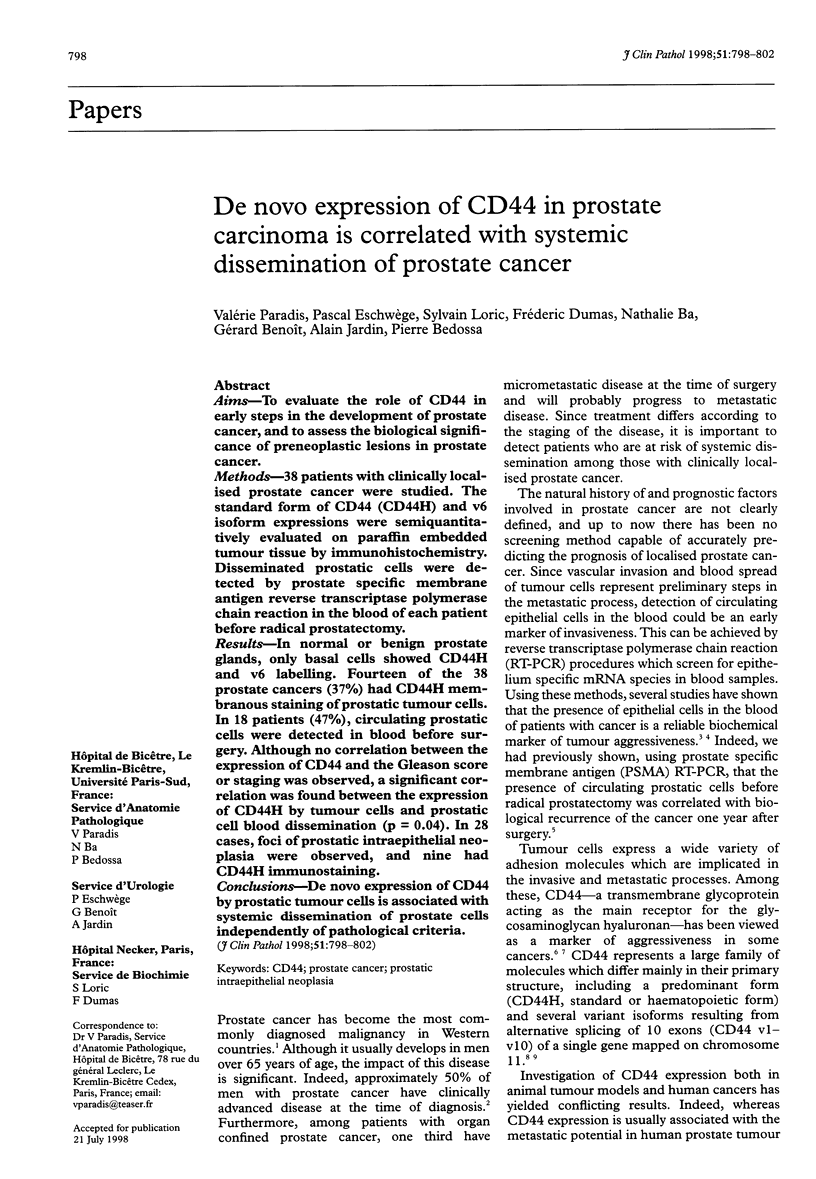
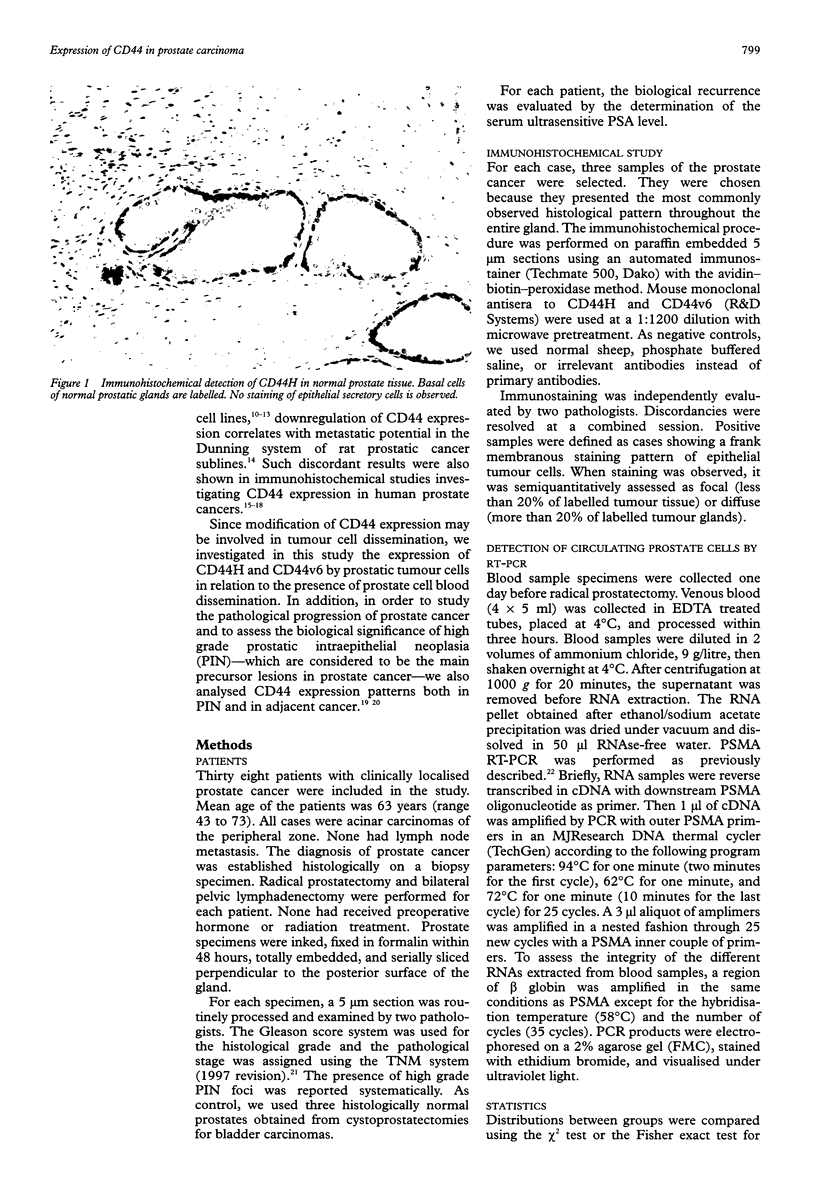
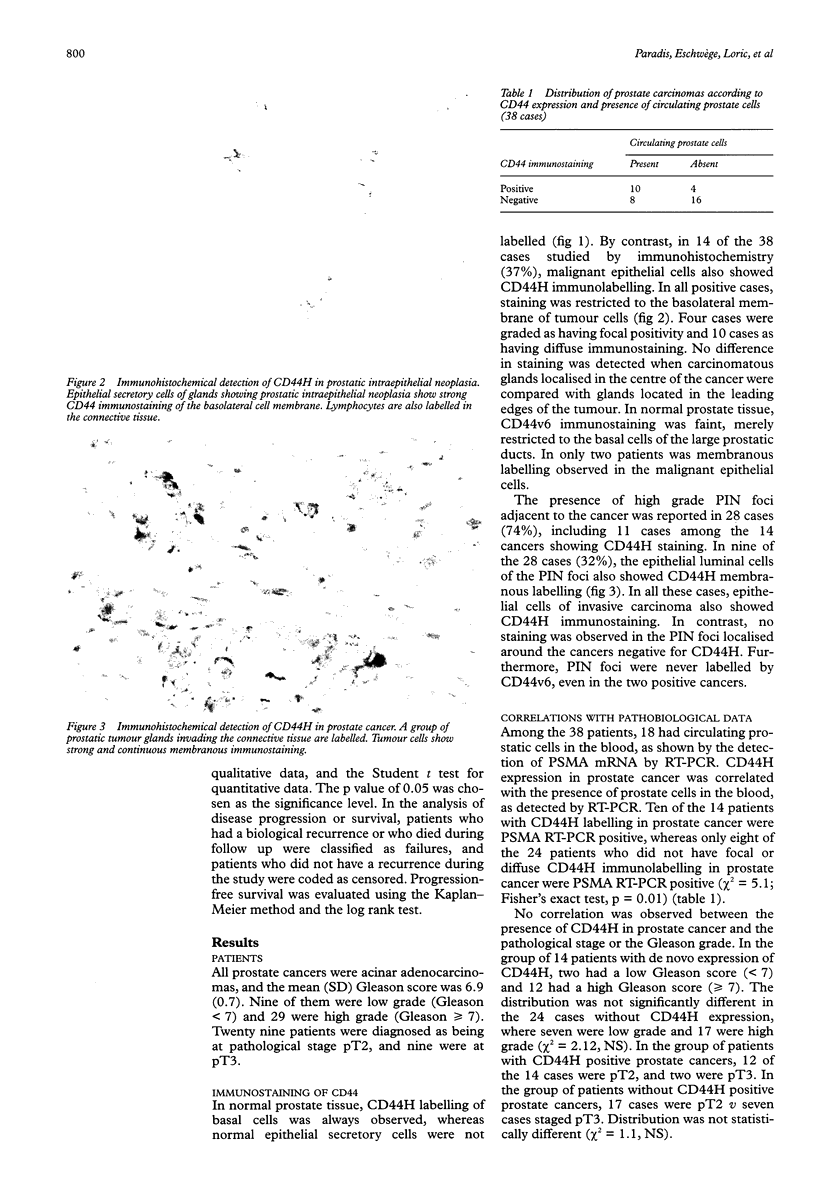
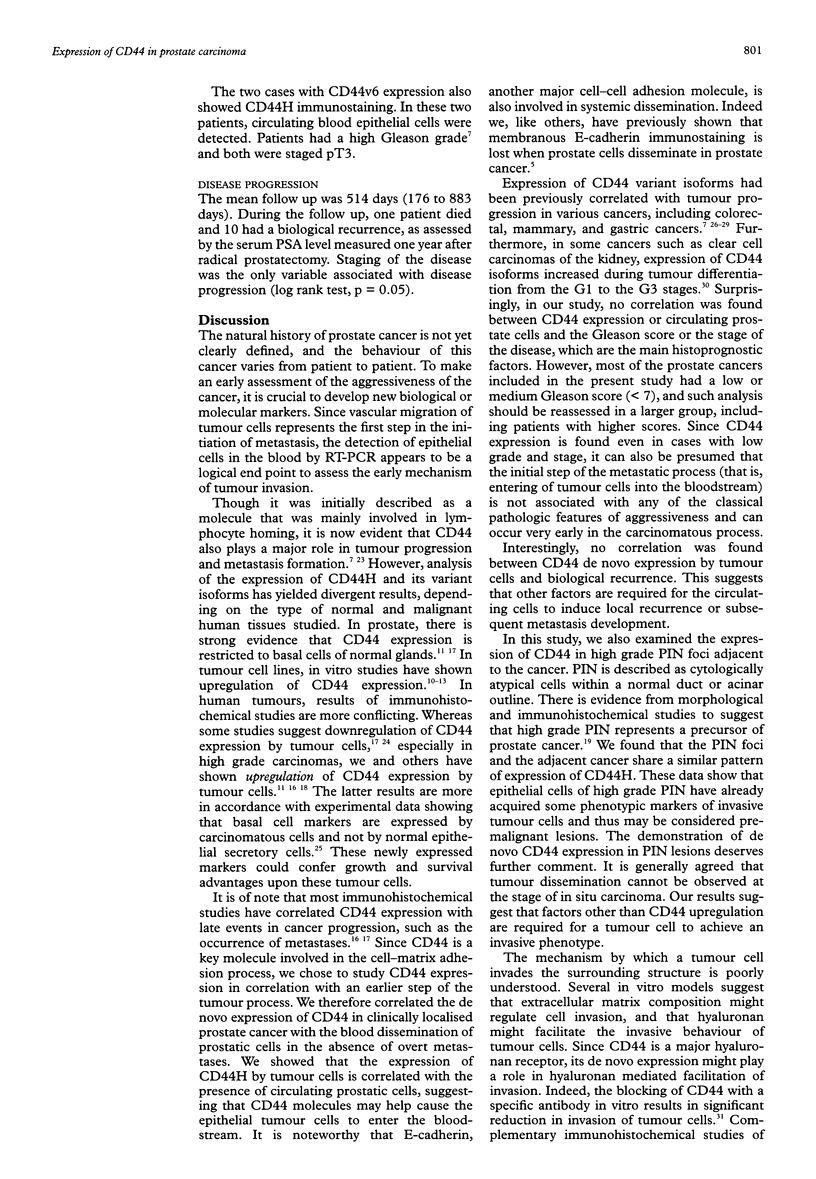
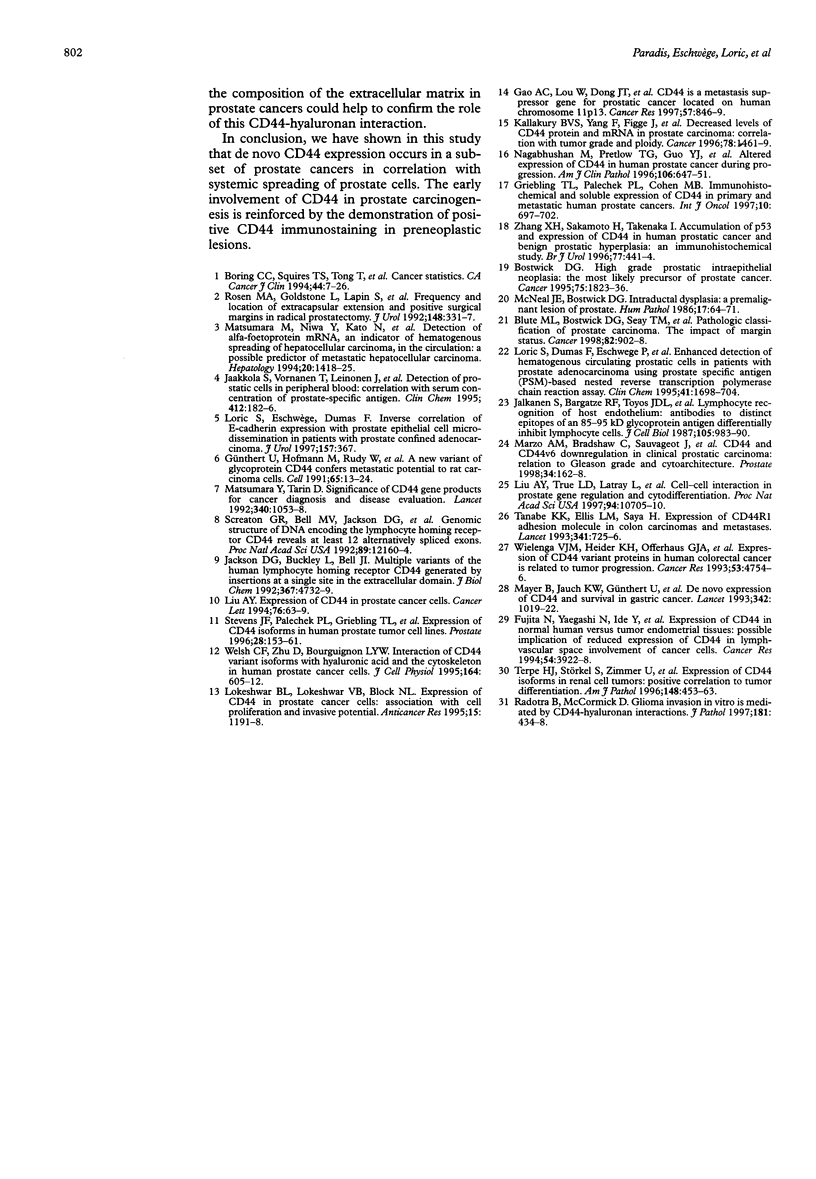
Images in this article
Selected References
These references are in PubMed. This may not be the complete list of references from this article.
- Blute M. L., Bostwick D. G., Seay T. M., Martin S. K., Slezak J. M., Bergstralh E. J., Zincke H. Pathologic classification of prostate carcinoma: the impact of margin status. Cancer. 1998 Mar 1;82(5):902–908. doi: 10.1002/(sici)1097-0142(19980301)82:5<902::aid-cncr15>3.0.co;2-4. [DOI] [PubMed] [Google Scholar]
- Boring C. C., Squires T. S., Tong T., Montgomery S. Cancer statistics, 1994. CA Cancer J Clin. 1994 Jan-Feb;44(1):7–26. doi: 10.3322/canjclin.44.1.7. [DOI] [PubMed] [Google Scholar]
- De Marzo A. M., Bradshaw C., Sauvageot J., Epstein J. I., Miller G. J. CD44 and CD44v6 downregulation in clinical prostatic carcinoma: relation to Gleason grade and cytoarchitecture. Prostate. 1998 Feb 15;34(3):162–168. doi: 10.1002/(sici)1097-0045(19980215)34:3<162::aid-pros2>3.0.co;2-k. [DOI] [PubMed] [Google Scholar]
- Fujita N., Yaegashi N., Ide Y., Sato S., Nakamura M., Ishiwata I., Yajima A. Expression of CD44 in normal human versus tumor endometrial tissues: possible implication of reduced expression of CD44 in lymph-vascular space involvement of cancer cells. Cancer Res. 1994 Jul 15;54(14):3922–3928. [PubMed] [Google Scholar]
- Gao A. C., Lou W., Dong J. T., Isaacs J. T. CD44 is a metastasis suppressor gene for prostatic cancer located on human chromosome 11p13. Cancer Res. 1997 Mar 1;57(5):846–849. [PubMed] [Google Scholar]
- Günthert U., Hofmann M., Rudy W., Reber S., Zöller M., Haussmann I., Matzku S., Wenzel A., Ponta H., Herrlich P. A new variant of glycoprotein CD44 confers metastatic potential to rat carcinoma cells. Cell. 1991 Apr 5;65(1):13–24. doi: 10.1016/0092-8674(91)90403-l. [DOI] [PubMed] [Google Scholar]
- Jaakkola S., Vornanen T., Leinonen J., Rannikko S., Stenman U. H. Detection of prostatic cells in peripheral blood: correlation with serum concentrations of prostate-specific antigen. Clin Chem. 1995 Feb;41(2):182–186. [PubMed] [Google Scholar]
- Jackson D. G., Buckley J., Bell J. I. Multiple variants of the human lymphocyte homing receptor CD44 generated by insertions at a single site in the extracellular domain. J Biol Chem. 1992 Mar 5;267(7):4732–4739. [PubMed] [Google Scholar]
- Jalkanen S., Bargatze R. F., de los Toyos J., Butcher E. C. Lymphocyte recognition of high endothelium: antibodies to distinct epitopes of an 85-95-kD glycoprotein antigen differentially inhibit lymphocyte binding to lymph node, mucosal, or synovial endothelial cells. J Cell Biol. 1987 Aug;105(2):983–990. doi: 10.1083/jcb.105.2.983. [DOI] [PMC free article] [PubMed] [Google Scholar]
- Liu A. Y. Expression of CD44 in prostate cancer cells. Cancer Lett. 1994 Jan 15;76(1):63–69. doi: 10.1016/0304-3835(94)90135-x. [DOI] [PubMed] [Google Scholar]
- Liu A. Y., True L. D., LaTray L., Nelson P. S., Ellis W. J., Vessella R. L., Lange P. H., Hood L., van den Engh G. Cell-cell interaction in prostate gene regulation and cytodifferentiation. Proc Natl Acad Sci U S A. 1997 Sep 30;94(20):10705–10710. doi: 10.1073/pnas.94.20.10705. [DOI] [PMC free article] [PubMed] [Google Scholar]
- Lokeshwar B. L., Lokeshwar V. B., Block N. L. Expression of CD44 in prostate cancer cells: association with cell proliferation and invasive potential. Anticancer Res. 1995 Jul-Aug;15(4):1191–1198. [PubMed] [Google Scholar]
- Loric S., Dumas F., Eschwege P., Blanchet P., Benoit G., Jardin A., Lacour B. Enhanced detection of hematogenous circulating prostatic cells in patients with prostate adenocarcinoma by using nested reverse transcription polymerase chain reaction assay based on prostate-specific membrane antigen. Clin Chem. 1995 Dec;41(12 Pt 1):1698–1704. [PubMed] [Google Scholar]
- Matsumura M., Niwa Y., Kato N., Komatsu Y., Shiina S., Kawabe T., Kawase T., Toyoshima H., Ihori M., Shiratori Y. Detection of alpha-fetoprotein mRNA, an indicator of hematogenous spreading hepatocellular carcinoma, in the circulation: a possible predictor of metastatic hepatocellular carcinoma. Hepatology. 1994 Dec;20(6):1418–1425. doi: 10.1002/hep.1840200607. [DOI] [PubMed] [Google Scholar]
- Matsumura Y., Tarin D. Significance of CD44 gene products for cancer diagnosis and disease evaluation. Lancet. 1992 Oct 31;340(8827):1053–1058. doi: 10.1016/0140-6736(92)93077-z. [DOI] [PubMed] [Google Scholar]
- Mayer B., Jauch K. W., Günthert U., Figdor C. G., Schildberg F. W., Funke I., Johnson J. P. De-novo expression of CD44 and survival in gastric cancer. Lancet. 1993 Oct 23;342(8878):1019–1022. doi: 10.1016/0140-6736(93)92879-x. [DOI] [PubMed] [Google Scholar]
- McNeal J. E., Bostwick D. G. Intraductal dysplasia: a premalignant lesion of the prostate. Hum Pathol. 1986 Jan;17(1):64–71. doi: 10.1016/s0046-8177(86)80156-3. [DOI] [PubMed] [Google Scholar]
- Nagabhushan M., Pretlow T. G., Guo Y. J., Amini S. B., Pretlow T. P., Sy M. S. Altered expression of CD44 in human prostate cancer during progression. Am J Clin Pathol. 1996 Nov;106(5):647–651. doi: 10.1093/ajcp/106.5.647. [DOI] [PubMed] [Google Scholar]
- Radotra B., McCormick D. Glioma invasion in vitro is mediated by CD44-hyaluronan interactions. J Pathol. 1997 Apr;181(4):434–438. doi: 10.1002/(SICI)1096-9896(199704)181:4<434::AID-PATH797>3.0.CO;2-S. [DOI] [PubMed] [Google Scholar]
- Rosen M. A., Goldstone L., Lapin S., Wheeler T., Scardino P. T. Frequency and location of extracapsular extension and positive surgical margins in radical prostatectomy specimens. J Urol. 1992 Aug;148(2 Pt 1):331–337. doi: 10.1016/s0022-5347(17)36587-4. [DOI] [PubMed] [Google Scholar]
- Screaton G. R., Bell M. V., Jackson D. G., Cornelis F. B., Gerth U., Bell J. I. Genomic structure of DNA encoding the lymphocyte homing receptor CD44 reveals at least 12 alternatively spliced exons. Proc Natl Acad Sci U S A. 1992 Dec 15;89(24):12160–12164. doi: 10.1073/pnas.89.24.12160. [DOI] [PMC free article] [PubMed] [Google Scholar]
- Stevens J. W., Palechek P. L., Griebling T. L., Midura R. J., Rokhlin O. W., Cohen M. B. Expression of CD44 isoforms in human prostate tumor cell lines. Prostate. 1996 Mar;28(3):153–161. doi: 10.1002/(SICI)1097-0045(199603)28:3<153::AID-PROS2>3.0.CO;2-G. [DOI] [PubMed] [Google Scholar]
- Tanabe K. K., Ellis L. M., Saya H. Expression of CD44R1 adhesion molecule in colon carcinomas and metastases. Lancet. 1993 Mar 20;341(8847):725–726. doi: 10.1016/0140-6736(93)90490-8. [DOI] [PubMed] [Google Scholar]
- Terpe H. J., Störkel S., Zimmer U., Anquez V., Fischer C., Pantel K., Günthert U. Expression of CD44 isoforms in renal cell tumors. Positive correlation to tumor differentiation. Am J Pathol. 1996 Feb;148(2):453–463. [PMC free article] [PubMed] [Google Scholar]
- Welsh C. F., Zhu D., Bourguignon L. Y. Interaction of CD44 variant isoforms with hyaluronic acid and the cytoskeleton in human prostate cancer cells. J Cell Physiol. 1995 Sep;164(3):605–612. doi: 10.1002/jcp.1041640319. [DOI] [PubMed] [Google Scholar]
- Wielenga V. J., Heider K. H., Offerhaus G. J., Adolf G. R., van den Berg F. M., Ponta H., Herrlich P., Pals S. T. Expression of CD44 variant proteins in human colorectal cancer is related to tumor progression. Cancer Res. 1993 Oct 15;53(20):4754–4756. [PubMed] [Google Scholar]
- Zhang X. H., Sakamoto H., Takenaka I. Accumulation of p53 and expression of CD44 in human prostatic cancer and benign prostatic hyperplasia: an immunohistochemical study. Br J Urol. 1996 Mar;77(3):441–444. doi: 10.1046/j.1464-410x.1996.85721.x. [DOI] [PubMed] [Google Scholar]





